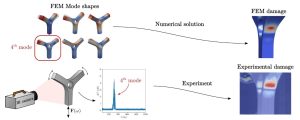Researchers at the Laboratory for Dynamics of Machines and Structures have developed a novel approach of identifying multiaxial vibration fatigue in frequency-domain using thermoelasticity, aiming to significantly improve the possibilities of full-field and real-time fatigue damage estimation. The results of the study were published in Mechanical Systems and Signal Processing (IF=7,9).
In the field of vibration fatigue, materials under multiaxial stress often fail unpredictably. Fatigue damage is typically localized (in time and space) and loads can change direction with time, meaning that the experimental damage identification with high-spatial-density is hard to conduct. Thermoelasticity provides a solution by enabling the detection of small temperature changes, offering a possibility for close-to-real-time full-field damage identification. Thermoelasticity studies the interaction between temperature changes and elastic deformations in materials: minute changes in temperature can be related to the sum of the normal stresses, providing information about the multiaxial stress state. Under adiabatic conditions, local heating under compression and local cooling under expansion can be observed. During harmonic excitation, the harmonic stresses in a solid material, produce a harmonic temperature response, related to the first stress invariant.
This research discusses the application of thermoelasticity in multiaxial criterion resulting in the equivalent uniaxial load. The researchers introduced a numerical formulation for the thermoelasticity-based multiaxial criterion, comparing its performance to the established Equivalent von Mises Stress (EVMS) criterion in frequency domain. The experimental component of the study utilized fast infrared thermal cameras to validate the numerical simulations.

Figure 1: Graphical abstract, demonstrating the numerical simulation of the multiaxial damage, calculated using the proposed thermoelastic criterion, in comparison with experimental identification of the damage using infrared camera.
The results demonstrated a strong correlation between simulated and measured damage, particularly in identifying critical points where fatigue damage is most likely to occur. The research revealed that the thermoelasticity-based criterion excels in identifying normal stresses, which are critical in many fatigue scenarios, such as bending, where cyclic tension and compression occur. This research opens new possibilities for non-contact fatigue monitoring, providing a more efficient tool for predicting material failure under dynamic loads. The advancements in vibration fatigue analysis and experimental methods lead to improvements in the design and maintenance of structures subjected to dynamic loads, ultimately reducing failure rates and extending service life.
